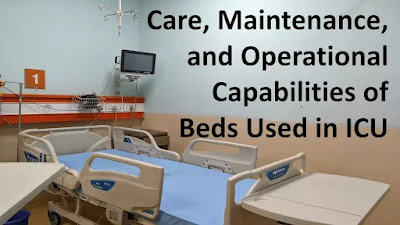Care, Maintenance, and Operational Capabilities of Beds Used in ICU
 |
| Care, Maintenance, and Operational Capabilities of Beds Used in ICU |
ICU beds are critical for patient care. Ensuring their
proper care, maintenance, and understanding of their operational capabilities is
essential. This comprehensive guide covers key aspects of effective ICU bed
management.
Care and Cleaning
Daily Cleaning Routine:
Establish a daily cleaning regimen that includes wiping down
surfaces, handrails, and controls with approved disinfectants to prevent
microbial buildup.
High-Touch Area Disinfection:
Prioritize disinfection of high-touch areas such as buttons,
remote controls, and handrails to minimize the risk of cross-contamination.
Mattress Assessment:
Regularly assess mattress conditions for signs of damage,
wear, or contamination, and replace compromised mattresses promptly.
Waterproof Covers Usage:
Utilize waterproof mattress covers to protect mattresses
from spills, fluids, and contaminants, contributing to infection prevention.
Scheduled Maintenance Checks:
Conduct routine inspections of bed frames, wheels, and
mechanical components to identify potential issues before they escalate.
Prompt Repairs:
Address maintenance or repair needs promptly to prevent
equipment failure, ensuring patient comfort and safety.
Brake System Care:
Regularly test and maintain the brake system to prevent
unintended movement and uphold patient safety during transfers.
Barrier Techniques Implementation:
Employ disposable bed linens and covers as barrier
techniques to minimize contamination risk between patients.
Effective Disinfection Protocols:
Adhere to effective disinfection protocols using approved
hospital-grade disinfectants to eliminate pathogens from bed surfaces.
Maintenance and Safety
Regular Inspections:
Conduct regular visual and functional inspections of bed
frames, wheels, and components to identify signs of wear, damage, or
malfunction.
Scheduled Maintenance:
Implement a scheduled maintenance plan based on manufacturer
recommendations to ensure optimal bed performance.
Brake System Vigilance:
Test and calibrate the bed's brake system regularly to
prevent unintended movement and ensure patient safety.
Electrical Component Check:
Inspect electrical components, wiring, connectors, and plugs
for signs of damage, wear, or potential hazards.
Emergency Lowering Mechanism:
Verify the functionality of the bed's emergency lowering
mechanism to ensure patient safety during power outages.
Side Rails and Controls:
Regularly assess the condition and functionality of side
rails, buttons, remote controls, and other control features.
Battery Backup Evaluation:
Check and maintain the battery backup system to ensure
uninterrupted bed functionality during power fluctuations.
Mechanical Parts Lubrication:
Lubricate mechanical parts, such as adjustable mechanisms,
to prevent friction-related issues and ensure smooth operation.
Collaboration with Technicians:
Collaborate with qualified technicians and manufacturers for
specialized maintenance and repairs to ensure safety and compliance.
Documentation and Logs:
Maintain detailed logs of maintenance tasks, inspections,
and repairs to track equipment history and compliance with protocols.
User Training:
Provide training to staff on basic troubleshooting and quick
fixes to address minor issues promptly.
Operational Capabilities
Enhanced Patient Monitoring Integration
Integrated Monitoring Systems:
ICU beds are equipped with integrated monitoring systems
that enable continuous patient assessment.
Vital signs, ECG, respiratory rate, and more can be
monitored and displayed on the bed's interface.
Real-Time Data Exchange:
ICU beds transmit patient data to centralized monitoring
stations, enabling healthcare professionals to respond promptly to changes.
Continuous data exchange enhances patient safety and reduces
response times.
Mobility and Patient Transfers
Height Adjustment:
ICU beds feature height-adjustable mechanisms that ease
patient transfers and medical procedures.
Proper alignment prevents strain on healthcare workers and
enhances patient comfort.
Lateral Rotation and Trendelenburg Positions:
Advanced ICU beds allow lateral rotation and Trendelenburg
positions for better patient positioning and pressure ulcer prevention.
These positions improve blood circulation and reduce the
risk of complications.
Integration of Medical Devices
In-Built Device Mounting:
ICU beds are designed to accommodate various medical
devices, such as infusion pumps, monitors, and ventilators.
Integrated mounting points enhance organization, reduce
clutter, and improve accessibility.
Smart Integration Interfaces:
Beds with smart interfaces enable seamless connectivity with
medical devices, allowing remote control and customization.
Integration streamlines workflows, reducing manual
interventions and enhancing patient safety.
Patient Engagement and Comfort
Entertainment Interfaces:
Some ICU beds incorporate entertainment interfaces, allowing
patients access to TV, internet, and communication tools.
Enhanced patient engagement contributes to reduced anxiety
and a more positive hospital experience.
Adjustable Comfort Settings:
Modern ICU beds offer adjustable comfort settings, including
mattress firmness, headrest elevation, and lumbar support.
Patient comfort can positively impact recovery outcomes.
CPR and Emergency Response
CPR Mode Activation:
ICU beds are equipped with CPR mode, facilitating quick
access to patients during emergencies.
This mode lowers the bed to a suitable height for immediate
life-saving interventions.
Clear Accessibility:
Beds are designed for clear access during emergency procedures,
ensuring healthcare professionals can administer CPR effectively.
Weight Limit:
Adhere to weight limit guidelines to prevent bed damage and
patient harm.
Use appropriate beds for bariatric patients.
Record-Keeping:
Maintain detailed records of maintenance tasks, inspections,
and repairs.
Document staff training sessions.
Proper care, maintenance, and understanding of operational
capabilities are integral to effective ICU bed management. Regular cleaning, thorough
inspections, adherence to safety protocols, and staff training contribute to
patient safety and optimal equipment performance. By implementing these
practices, healthcare facilities ensure that ICU beds remain functional,
reliable, and supportive of critical patient care needs.
Recommended Topics
Label List
- BASIC CONCEPTS (19)
- ANESTHESIA EQUIPMENTS (18)
- Exam (13)
- study material (12)
- MCQ FOR OT TECHNICIANS (11)
- ANESTHESIA PREPRATION (10)
- DEVICES USED IN OT (7)
- random topics (7)
- CSSD & OTHER DEVICES (6)
- FIND A JOB (5)
- QUESTION PAPERS (5)
- latest updates (4)
- DRUGS (3)
- PATIENT CARE (3)
- Registration (3)
- Surgical Instruments (3)
- History of Anesthesia (2)
- by - Ritika Sharma (1)

Post a Comment
Post a Comment